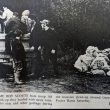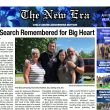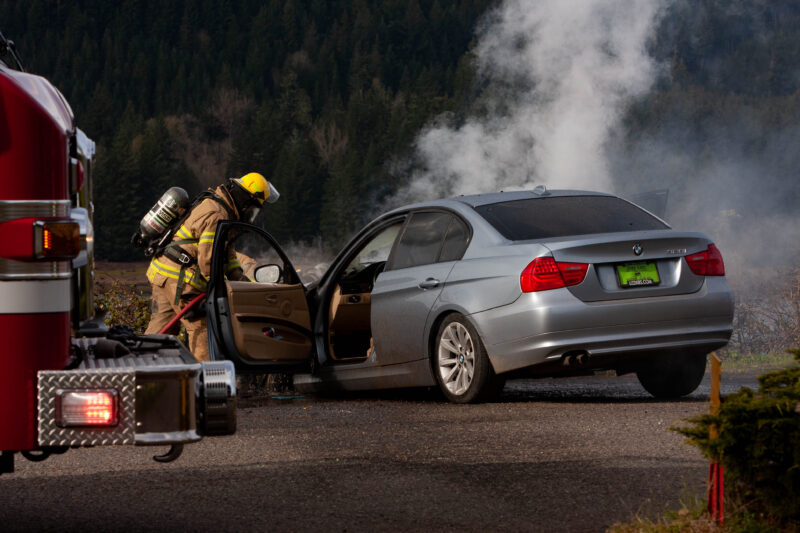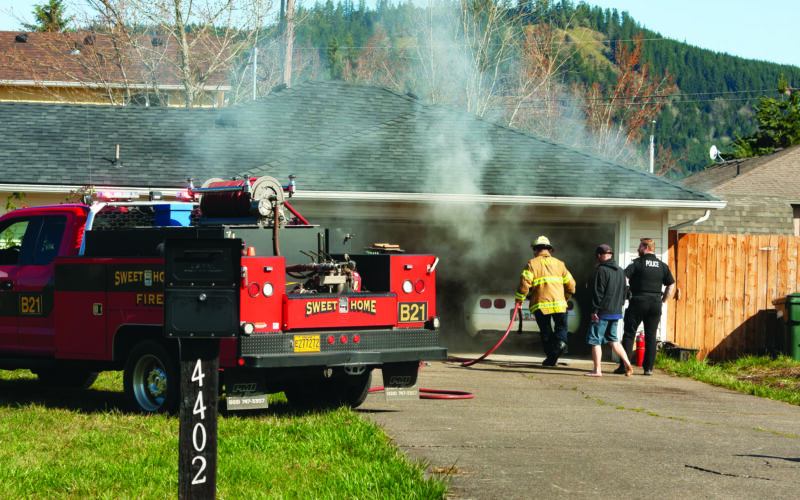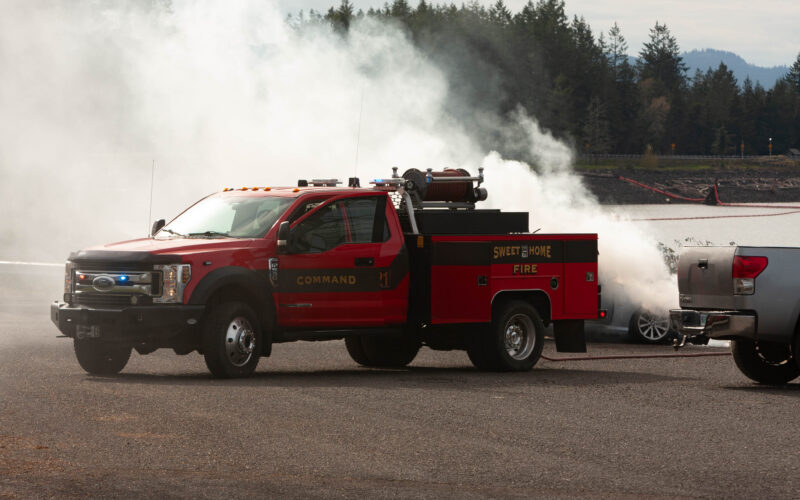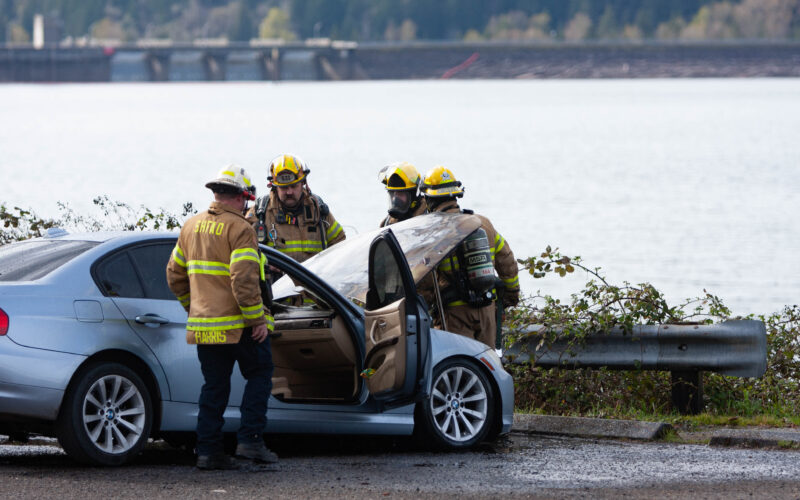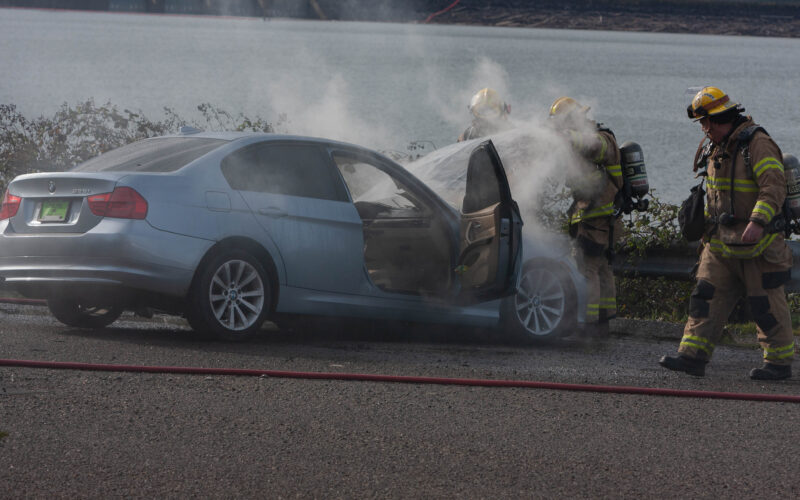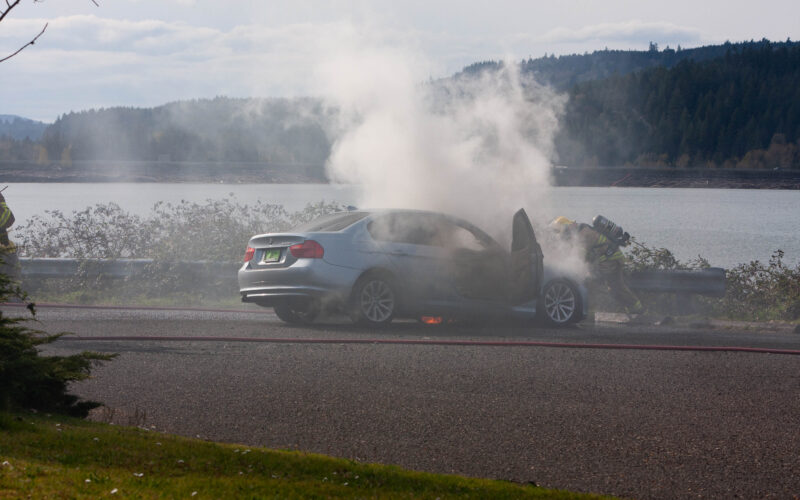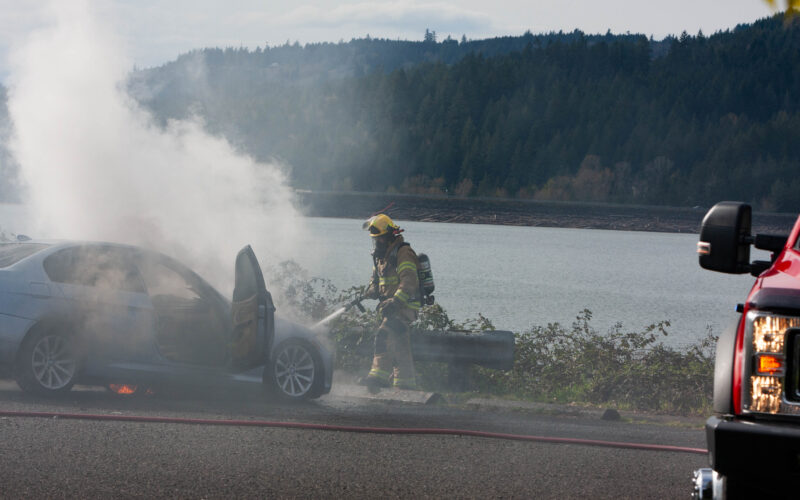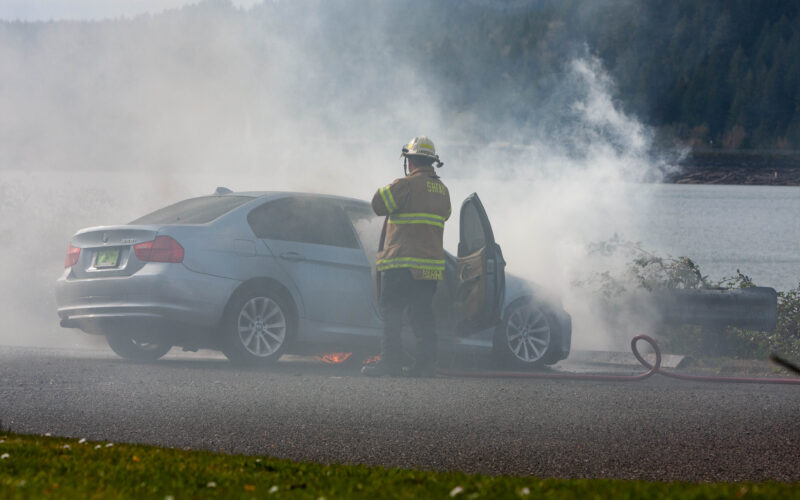Two separate incidents of car fires within the span of a week along with many other calls have raised concerns for the Sweet Home Fire and Ambulance District (SHFAD), shedding light on the challenges faced by emergency responders amidst a surge in service demands.
The initial incident unfolded on March 17 when flames erupted from a 1987 Corvette parked in an attached garage. The call came in as a structure fire; however, upon arrival SHFAD found it was the car in the garage that was on fire.
The owner, who had intended to take the vehicle out for a Sunday drive after a month of inactivity, started the car only to witness flames engulfing the engine compartment shortly thereafter. Quick action from neighbors, armed with fire extinguishers, and emergency responders prevented extensive damage. However, the incident served as a stark reminder of the potential dangers posed by older vehicles and electrical malfunctions.
Eli Harris, Battalion Chief for SHFAD, provided insights into the harrowing ordeal. “The call came in as a structure fire at 10:46 a.m.,” Harris said.
He continued, “They had not driven it for about a month and they were gonna take it out for a Sunday drive. The battery was dead the night before, so they put it on a battery charger. That morning they started it up on the battery charger. It started up fine. They disconnected the battery charger and left the hood up while it warmed up in the garage with the door open.
When they came out about 10 minutes later, there were flames in the engine.”
Neighbors, alerted by the commotion, rushed to the scene, armed with fire extinguishers. Their swift intervention played a crucial role in containing the blaze until emergency services arrived. “The majority of the fire had been subdued by neighbors wielding fire extinguishers,” Harris noted. “Their actions undoubtedly prevented a more catastrophic outcome.”
SHFAD determined the fire to be caused by an electrical issue. “The battery had cooked almost in half and fell through the bottom of the engine compartment and was laying behind the front left tire. That one I would say was an electrical issue,” said Harris.
As emergency responders secured the scene and assessed the damage, concerns lingered over the potential for escalation. “With a car fire in a garage, the risks are amplified due to the confined space and proximity to the home,” Harris emphasized. “It’s fortunate that the neighbors acted swiftly and that we were able to contain the fire before it spread further.”
The second incident occurred on March 21, when a 2011 BMW 328i burst into flames. According to Harris, the owner reported experiencing engine problems the night before, leading them to park the vehicle overnight. The following day, attempts to start the car resulted in a loud bang followed by smoke and flames emanating from the engine compartment.
Harris, who swiftly responded to the scene, described the expedited efforts to contain the blaze. “The call came in at 4:35 p.m., and we were en route within a minute,” Harris recounted. “Upon arrival at 4:40 p.m., our priority was to contain the fire, which had quickly spread.”
Despite the rapid intervention, the exact cause of the fire remains uncertain. Harris speculated mechanical failure, citing the absence of a definitive explanation for the ignition. “While it’s tempting to attribute it to a backfire or battery issue, given the absence of a carburetor and a functional battery, we lean towards mechanical failure,” Harris stated.
The second car fire set off a chain of seven more calls back to back leaving SHFAD grappling with an onslaught of emergency calls and not enough equipment to respond.
“Shortly after responding to the car fire, we found ourselves inundated with a barrage of emergency calls,” Harris revealed. “Within the span of an hour, we received a total of seven calls, stretching our resources to the limit.”
Harris explained, “So we had the car fire, and I got off that scene at 5:42 p.m. We had another call at 5:58 p.m., which was a medical call and then another one at 6:03 p.m. And that took both of my ambulances out of the district to go handle those calls. Then we received a smoke investigation call. The smoke investigation ended up only being some slag piles that were burning, but it took me a while to locate them. I was up there locating those at 6:17 p.m. While these other two medical calls were going, and while I was up there, three more calls came in at 6:30 p.m., 6:47 p.m., and then another at 6:57 p.m. for medical calls.”
Harris described the scene as a “juggling act,” with limited personnel and resources.
“By 4:35 p.m., when the car fire call came in, our team was already stretched thin,” Harris explained. “The subsequent calls further strained our capacity to provide timely and comprehensive emergency services.”
Despite the challenges, Harris and his team mobilized with remarkable efficiency, prioritizing critical calls and coordinating with neighboring fire departments to address the surge in demand. Mutual aid agreements with nearby agencies, such as Lebanon and Albany, played a crucial role in augmenting SHFAD’s response capabilities during times of heightened need.
“Our partnerships with neighboring fire departments proved invaluable,” Harris acknowledged. “Their assistance enabled us to maintain a level of service despite the overwhelming volume of calls.”
Harris says the influx of calls on a daily basis is occurring more and more frequently though he doesn’t attribute it to anything beyond regular every day calls. Harris said typically there are many times the battalion chief is alone at the station when they get calls or they may have just one other person with them.
Harris stated for calls that they don’t have an ambulance right away for they will assess the emergency and determine the level of need for each patient to ensure the most serious cases are attended to first.
“What we’ll do is we’ll go to the house of the call and check and make sure there’s no life saving measures that need to be made. If there’s not we continue on and a lot of the time I have the opportunity before that to pre-position a Lebanon ambulance at Santiam Terrace. They come halfway down and they wait so they can guardian angel us, and they stay there,” explained Harris.
Harris said many times he will go to the scene to determine the level of need only to find Lebanon already on their way. “If I tell him no, don’t worry about it, they don’t need transport. They’ll turn around and go wait back at Santiam Terrace, at that halfway mark, but a lot of the time, I have to tell him yes, come on in, I need to transport this one.”
Harris explained that he will provide care until they get there explaining this is his best method of response during heavy call volume times. “If I was to take an ambulance and do that and then transport them, the next call might be a cardiac arrest where we need to have immediate action. It’s getting harder and harder to provide for that, so what we’ve done is established a relationship with Lebanon and with Albany to handle the extra stress”
The SHFAD’s dispatchers play a critical role in ensuring there’s transportation available for all emergencies. “Our dispatchers are very good at making sure that we have some sort of coverage. At one point during that time, on the 21st they said Lebanon doesn’t have any ambulances either. I said, well, I need something. And she goes, I’ll get one coming from Albany. And she did. That Albany Medic Unit came right in and they took one of those patients for us.”
He further explained, “It wasn’t a critical patient, it was someone that just needed to be transported to the hospital, luckily, but my Quick Reaction Team (QRT) was running two other calls at the time to determine which one needed the most immediate care. We’re out of ambulances at that point.”
Harris said, “It’s a relationship between us and Lebanon, and it’s very rare that we have Albany in the mix but that day we did and they were right there. They helped us out.”
However, according to Harris, the multiple incidents at once without enough equipment to respond underscores SHFAD’s need for additional resources and staffing to ensure the community’s safety and well-being.
Harris said, “We’re looking at it and trying to upstaff, but staffing is becoming difficult, it’s a matter of personnel and equipment is always an issue. We’re always fixing something or having something worked on and aging equipment is always an issue. It’s a bit of a mix. SHFAD has been proud to consistently provide a service that we think we can maintain, but sometimes it’s by the skin of the skin of the teeth. It’s a little more often than I like, to be honest.
Harris said SHFAD Chief Nick Tyler was also actively searching out other avenues to curtail and get in front of the issues they are facing. “I know what this bond that’s coming up, he’s trying to get in front of it with by providing a couple more ambulances and retaining some personnel.”
He also explained how the radios slotted in the bond SHFAD seeks in May will be a huge asset to the district especially when it comes to ensuring everyone has assistance when it’s needed. “Just being able to talk to dispatch, there’s times, if I go 10 minutes out of town past Foster, there’s oftentimes I’m talking to somebody at the station so that they can relay information to dispatch so that we can get extra units,” said Harris.
He further said, “I was happy to have Lebanon and Albany, at least available when they were and there was a point where there were 11 calls and Lebanon said, ‘Hey, you’ve used all our ambulances, when yours gets free from the hospital, can we have it here?’ I said yes, we were trading ambulances at one point like cars.”
Harris said, “East Linn is just helping itself out and it’s a good thing we have those relationships with our neighboring fire departments.”

